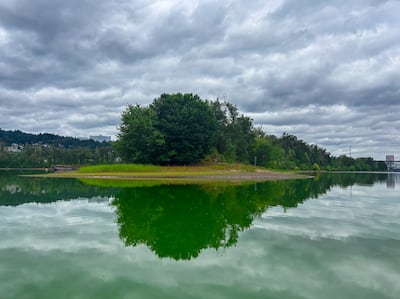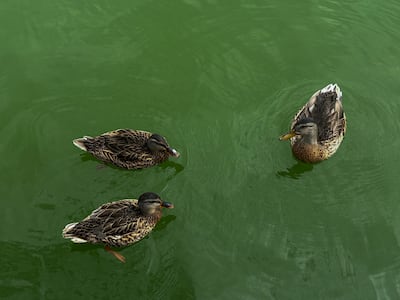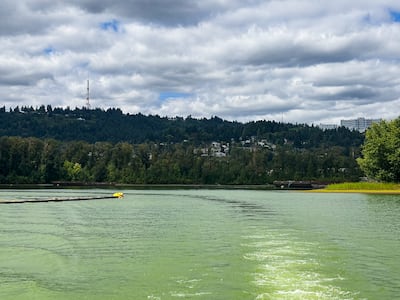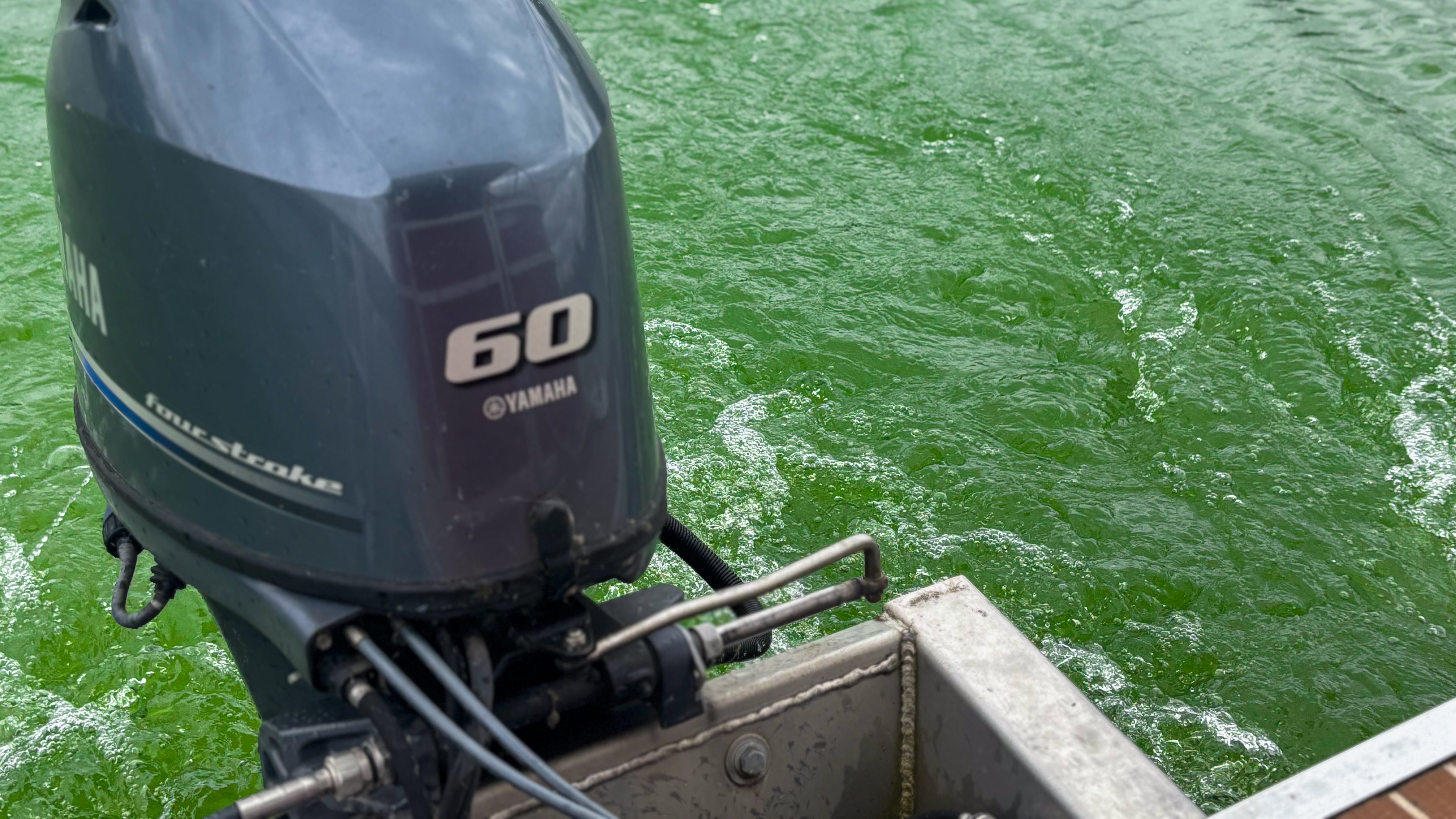Toxic algae blooms in the center of the Willamette River have become one of Portland’s unwanted summer traditions. The blooms erupt in Ross Island Lagoon, a stagnant inlet left by gravel mining; by now, Portlanders are used to steering clear of the emerald-green water that materializes during warmer temperatures.
This year was supposed to be different. Thanks to environmental watchdogs who brought legalaction, state regulators and the gravel mining company that owns much of the island crafted a plan to keep more of the algae contained inside the lagoon.
Conditions in the river over the past week raise questions whether that stopgap measure is sufficient to protect public health.
As of Aug. 16, the Oregon Health Authority is advising people to avoid swimming and high-speed water activities in a 15-mile stretch of the Willamette River from Ross Island to Kelley Point Park due to the lagoon’s latest algae bloom.
This is one of the largest advisories issued in recent years, but OHA has been putting out near-annual warnings since 2014.

While these advisories are routine for Multnomah County, toxic algae blooms are not typical for rivers; they normally manifest themselves in ponds and lakes. The fact that the Willamette River is still subject to them, river access advocates argue, stands as a sign of preventable failure—especially because new solutions that were meant to be implemented for the first time this year to prevent spread of the bloom did not bring promised results.
Willie Levenson, ringleader of the Human Access Project, has been working with Oregon State University professor Dr. Desiree Tullos since 2017 to address the issue, and the pair has proposed a solution: cut a notch in the lagoon to restore water flow to mitigate bacteria growth. A bill supporting the plan died in an Oregon legislative committee this year, but up until now Levenson had faith that a 2024 settlement would bring some change in the short term.
“When a harmful algae bloom forms on a river, you can trace it to the hand of a human being that did bad engineering,” said Levenson, who described the most recent algae bloom as a result of ongoing “bureaucratic failures.”

Cyanobacteria threaten humans, pets, marine life, and the environment. Dogs can die within minutes to hours of ingesting particles; humans can fall seriously ill. Salmon suffer from oxygen depletion and reduced food sources, not to mention the variety of other animals that call the lagoon home, including river otters, deer and beavers.
The blooms are a legacy of the Ross Island Sand and Gravel Company, the mining outfit that is part of the crumbling empire of Robert Pamplin Jr., who is now selling off his properties across Oregon to settle legal action by the U.S. Department of Labor. For decades, RISG mined the riverbed and connected two islands to create a lagoon. The result was a shallow body of stagnant water that, when warmed, was a perfect environment for cyanobacteria (toxic algae) to fester. The company ceased operations in 2001, but the ramifications of the lagoon structure remain.
Last fall, it appeared as though RISG would finally be held accountable going forward.
In 2023, the Northwest Environmental Defense Center filed a lawsuit against the Oregon Department of Environmental Quality over its water quality certification for Ross Island Sand and Gravel. The parties reached a settlement in October 2024, and DEQ’s new water certification requires Ross Island to deploy a boom—a protective barrier—and a silk curtain across the mouth of the lagoon opening to contain bacteria, as well as mechanically skim to disrupt proliferation within 24 hours of an OHA advisory.
This is the first algae bloom that has occurred since the settlement, and therefore the first time Ross Island Sand and Gravel has been held to the new standards. But Levenson and Tullos say the company is out of compliance. Not only is there no evidence of mechanical skimming, but the boom is haphazardly constructed and does not cover the length of the mouth, Tullos and Levenson observed on an Aug. 14 boat ride out to the lagoon.
“It is our belief that this does not comply with the language or spirit of the [certification] conditions,” said Mary Stites, an NEDC attorney. “At its core, DEQ is not exercising their discretion to tell Ross Island, ‘This boom is not sufficient.’”

DEQ spokesman Michael Loch told WW that the agency has not identified any violations of its certification requirements. The barrier must “allow boat access, so it cannot close off the entire opening to the lagoon,” he said. He also noted that skimming has yet to take place because the toxicity results from the most recent sampling have not yet been returned, and thus the presence of harmful algae has not been officially confirmed.
Ross Island Sand and Gravel could not be reached for comment, though a former employee confirmed to WW that the floating boom and turbidity curtain were the mitigation methods agreed upon with DEQ.
The boom, which covered roughly half of the mouth of the lagoon after the 24-hour period was up, is essentially ineffective in containing the spread of cyanobacteria unless the barrier stretches as far across the mouth as possible with a small gap for boats, according to Levenson.
Moreover, Levenson faults slow public notification by OHA , whose lack of urgency would subsequently shield RISG from taking immediate action. He and Tullos conducted tests and were aware of the bloom as early as Aug. 8. They spread the alarm, but it was not until several days later that the OHA put out its advisory. That gap was previously reported by the Oregon Capital Chronicle.
OHA partners with the DEQ when issuing alerts, and told WW in a statement that it informs the public as soon as DEQ staff provides a visual assessment and supporting documentation to OHA of a potentially hazardous bloom.
“OHA follows consistent, science-based protocols for issuing HAB advisories for water bodies,” said authority spokeswoman Erica Heartquist.
Looking forward, Levenson says it’s time for someone to step up and take accountability. Right now, the variety of entities—DEQ, OHA, the Department of State Lands—is missing a “central brain” and lacks coordination, he says.
“We’re happy to help the state, but we feel like we have the burden now to disseminate this information to the public,” he said. “When are you going to come in and help?”

